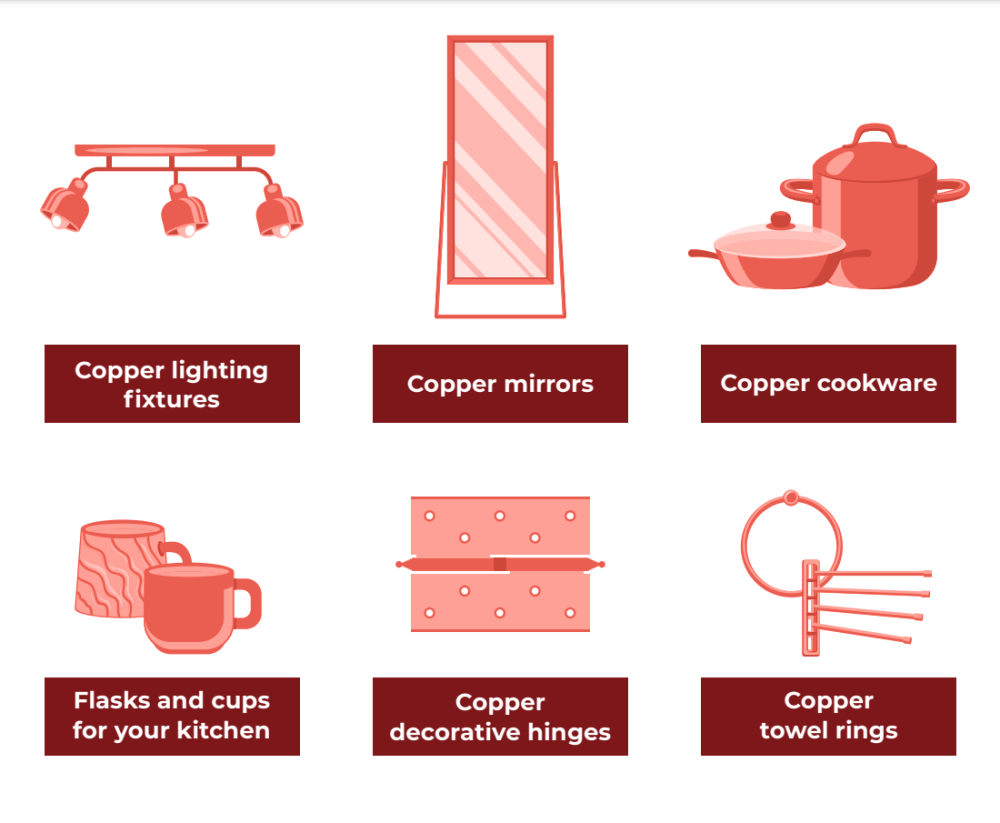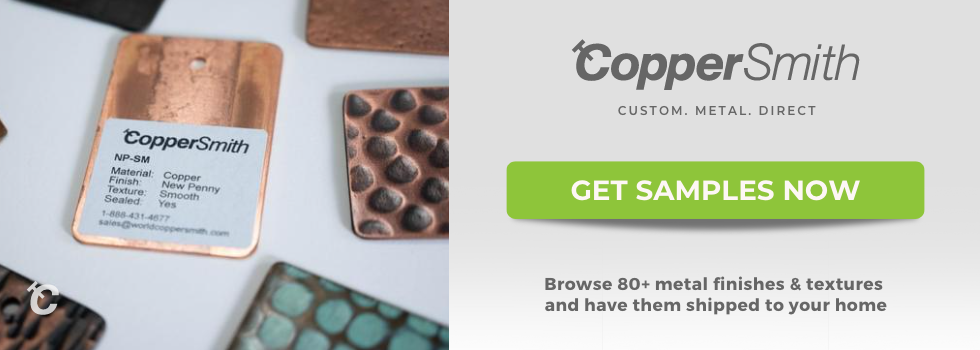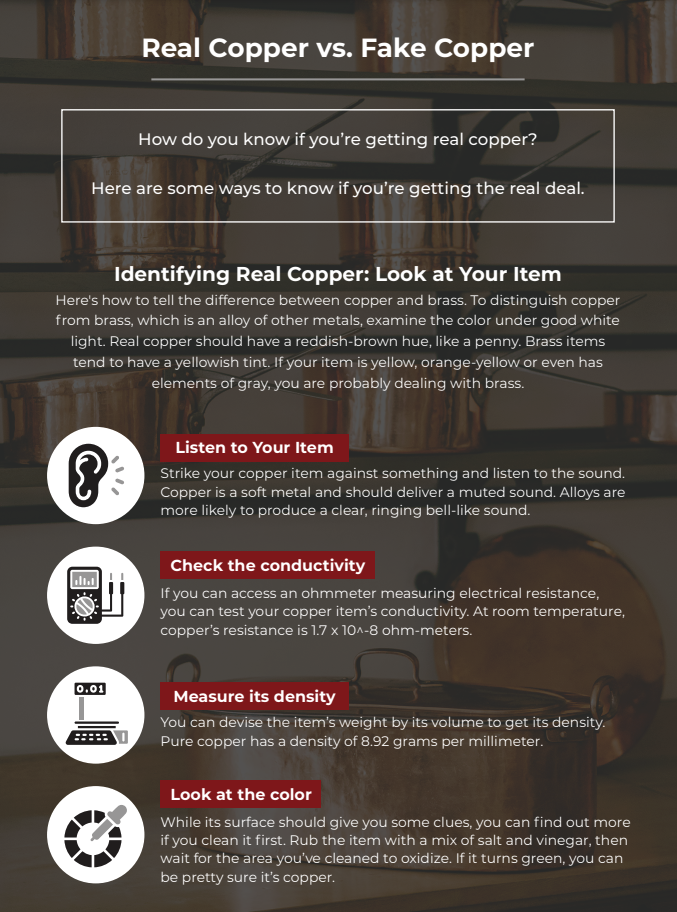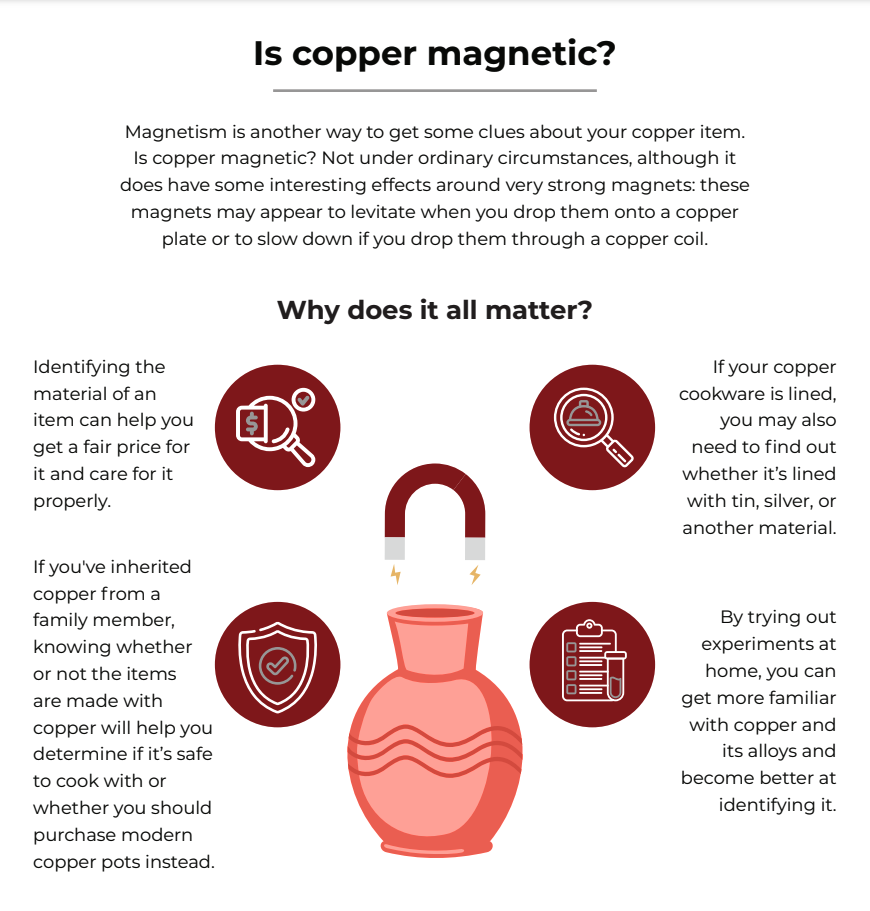
decor is a great way to beautify your home. Copper is a timeless metal that fits in with almost any interior design, and copper decorative items are easy to add to your existing arrangement to beautify and enhance a room’s natural character.
 Types of copper decor items you may add to a room may include:
Types of copper decor items you may add to a room may include:
- Copper lighting fixtures
- Copper mirrors
- Copper cookware
- Flasks and cups for your kitchen
- Copper decorative hinges
- Copper towel rings
Copper is a great way to create a comprehensive design theme for a kitchen or bathroom, but it works in almost any room in the house.
Real Copper vs. Fake Copper

But how do you know if you’re getting real copper? If you’re actually buying brass or copper-lined tin, you’re not only overpaying for your item, but you’re also getting an item that will not have the lasting effects that you buy copper for. Your item may corrode or rust and may look worn out over time, rather than developing a richer, natural-aged patina as a living finish copper item does. Here are some ways to know if you’re getting the real deal.
Identifying Real Copper: Look at Your Item
Here's how to tell the difference between copper and brass. To distinguish copper from brass, which is an alloy of other metals, examine the color under good white light. Real copper should have a reddish-brown hue, like a penny. Brass items tend to have a yellowish tint. If your item is yellow, orange-yellow or even has elements of gray, you are probably dealing with brass.
Listen to Your Item
Strike your copper item against something and listen to the sound. Copper is a soft metal and should deliver a muted sound. Alloys are more likely to produce a clear, ringing bell-like sound.
Check the conductivity
If you have access to an ohmmeter, which measures electrical resistance, you can test your copper item’s conductivity. At room temperature, copper’s resistance is 1.7 x 10^-8 ohm-meters. You can be sure that your item isn’t pure copper if the resistance is much higher or lower than this.
Measure its density
Another scientific test you can run on the item is to measure its density. This may be a little tricky if you don’t know the item’s volume. If you do, you can device the item’s weight by its volume to get its density. Pure copper has a density of 8.92 grams per millimeter.
Look at the color
Finally, take a closer look at the item’s color. While its surface should give you some clues, you can find out more if you clean it first. Rub the item with a mix of salt and vinegar, then wait for the area that you’ve cleaned to oxidize. If it turns green, you can be pretty sure it’s copper.
Is copper magnetic?

Magnetism is another way to get some clues about your copper item. Is copper magnetic? Not under ordinary circumstances, although it does have some interesting effects around very strong magnets: these magnets may appear to levitate when you drop them onto a copper plate, or to slow down if you drop them through a copper coil. The interaction actually creates a small electrical current, and is the same principle used in mechanically-powered flashlights, such as the dyno torch or the shake flashlight. When the magnet passes by the copper, either by spinning or shaking it, the electrical current charges the battery and causes the bulb to light up. Why does copper behave like this? Copper is actually diamagnetic, which means magnets repel it rather than attract it. Metals that are permanently magnetic, such as iron, are ferromagnetic. So, no, your copper item won’t stick to the refrigerator. If you put a magnet on your metallic item and it sticks, then it’s most likely iron, steel, or some other ferromagnetic material.
How to identify copper pennies
Copper pennies are some of the easiest copper items to identify, so they’re a great starting point for testing your copper detective skills or for creating an easy science experiment for the kids. Pennies are made from one of two materials: pure copper, or zinc with a copper coating. There are four ways to test for a copper penny:
- First, look carefully at the penny’s color. Zinc pennies may have a spotty, uneven look, while copper pennies are more likely to appear orange or even chocolate.
- Second, drop the penny onto the table and listen to the sound it makes. In this case, the copper penny should have a “ringing” sound, while the zinc penny will “clunk.”
- Third, you can weigh the penny. You’ll need a precise scale that weighs in grams. The copper penny should weigh 3.11 grams, while the zinc penny weights 2.5 grams.
- Finally, look at the date. If your penny was minted before 1982, it will be made of 95% copper and 5% zinc. Starting in 1982, pennies contained only 2.5% copper and 97.5% zinc. Pennies made in 1982 could be made of either of the two compositions.
Why did the U.S. Mint switch from copper to zinc pennies? Basically, they were concerned that the price of copper was so high that it would be more valuable for people to melt down the pennies and sell them as scrap metal — a practice that is illegal under U.S. law. So if you’re thinking of melting down copper pennies for profit, you might want to reconsider — unless it’s for art. The law makes an exeption for “educational, amusement, novelty, jewelry, and similar purposes.” There’s one more reason to be aware of what your pennies are made of. The newer zinc pennies are toxic to dogs, while the older copper pennies are not. (This doesn’t mean that eating old pennies is good for them — just that it’s less likely to require emergency intervention!)
Speak to a Professional for Help
Still not sure about whether a decor item is really copper? If you've examined your piece using the above techniques without any luck, it can be helpful to speak to a professional. Someone who is familiar with copper and other metals will be able to determine the truth for you so that you don't have to. You might find it helpful to approach a home design expert, an antique expert, or someone who works with metals to help you.
However, keep in mind that an expert may do many of the things that you can do yourself. Although they might be able to determine more quickly whether something is made from copper or not, they will often use the same tricks. So before you get in touch with any kind of expert, especially if you will be paying them, go through the steps yourself to try and get to the bottom of the mystery. It could take a little time, but save you some money.
Why You're in Luck If It's Copper
When an item does turn out to be real copper, it's definitely good news. Copper not only looks fantastic but can deliver a number of other excellent benefits too.
Some of the benefits you can see from copper decor items include:
Hygiene
Copper has been shown to have antimicrobial properties, killing off germs that end up on its surface. That means that any copper items you have in your home are easier to keep clean and hygienic. They'll help to prevent the spread of germs and only require a quick wipe with a soft cloth to keep them clean most of the time.
Long-Lasting
If it's made of copper, you can guarantee it's going to last a long time, especially if you care for it. Most metals are pretty durable, and you can count copper as one of them. You can also keep copper items looking nice and shiny too, as long as you polish them regularly. And it's not just the integrity of copper that's sure to last. The popularity and stylishness of copper endures too, offering a timeless material to use around your home.
Improves with Age
For many people, one of the best things about copper decor is that it gets better with age. You can choose to keep it looking the same with regular polishing, but you can also allow the metal to age and evolve. As copper gets older, you can begin to see it changing color, perhaps getting darker or even showing elements of green and blue as it begins to take on a unique patina.
How to Use Copper Decor in Your Home
It's amazing to discover that you do actually have a copper item that you can use to decorate your home. The next question is: how do you use copper as a decorative material? The great thing about copper is that it can be more than decorative. It's also a very practical material that offers plenty of functionality.
You can use copper in a lot of different ways, whether it's for big-ticket items or smaller home accessories. It could create a feature out of your sink or range hood in the kitchen, or it could give you decorative items in the form of copper plant pots. Plenty of copper items can be both decorative and functional. Copper cookware, such as pots and pans, is both stunning and practical. It works with all types of stovetops, including induction stoves. It conducts heat well, making cooking easier. And when you're not using it, there's no need to hide it away in your cabinets. Display it proudly and use it to enhance your kitchen.
When you're using copper purely for pretty decor, you have a huge range of ways to do that too. You can incorporate copper into different parts of your home. A copper backsplash in the kitchen or copper ornaments in the dining room could both look amazing. Copper works for different decor styles too. Whether you like industrial, French country, English heritage, or anything else, you can use copper elements.
Your decor items don't have to be real copper to look nice. However, real copper can last longer and remains beautiful. It's also more valuable, and even more hygienic. Identifying an item as real copper reassures you that it's going to continue brightening up your home. It's worth taking the time to do a little investigation and find out what you're looking at.
Why does it all matter?
Ultimately, does it really matter if your items are made out of copper or not? What are the situations in which you might need to identify an item’s material? One reason is if you’re purchasing antiques at a garage sale or estate sale. The authenticity of the item will help you get a fair price for it and care for it properly. This can also be a factor when searching for authentic handcrafted items. Another is if you’ve inherited copper from a family member, especially if it’s cookware. Knowing whether or not the items are made with copper will help you determine if it’s safe to cook with or whether you should purchase modern copper pots instead. If your copper cookware is lined, you may also need to find out whether it’s lined with tin, silver, or another material. Of course, some of these methods require time and tools, and you may not be able to perform all of these tests at the antique store or flea market. But by trying out these experiments at home first, you can get more familiar with copper and its alloys and become better at identifying it.
Buy Your Copper From a Reputable Source
One way to be sure you’re getting real copper is to buy your copper from a known name in the industry. CopperSmith sells the widest collection of real copper and real recycled copper products and has been a leading wholesaler and retailer of premium metal home products for years, so you know you can rely on us for quality copper sinks and other premium decor items. To learn more about CopperSmith’s beautiful copper items or to place an order, give us a call at 1-888-431-4677 or email us at [email protected]. You can also request more information by filling out our handy online contact form!





